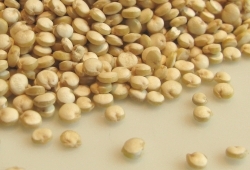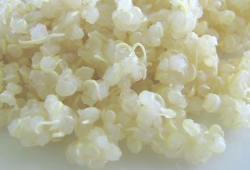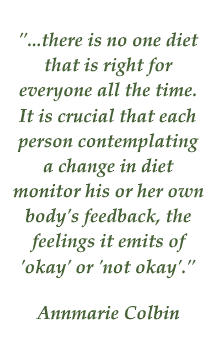Cooking Quinoa
Quinoa is a wonder grain worth getting to know! And cooking quinoa is not difficult as long as you make sure the natural coating has been removed. See here for more on quinoa's nutritional benefits.
Nature protects the quinoa grains with a bitter, soap-like coating of saponin that will create a bitter-tasting cooked grain if it isn't removed or destroyed first. There are several easy methods of doing this:
- simple rinsing with water in a fine mesh
strainer until the water runs clear. Alternatively, you can set the
strainer in a bowl of water and rub the grains with your fingers,
replacing cloudy water with fresh water until it remains clear.
- soaking the grains will not only destroy the saponin
but creates a more nutritious and easily digested grain. To soak 1 cup
of quinoa, cover with 3 cups of warm water, and add 1 tablespoon yogurt,
whey, kefir, or buttermilk. Allow to sit for several hours and up to 24
hours (if you must go longer, put it in the
fridge until you're ready to cook). Drain water and rinse grains, then
add fresh water for cooking. They may look like they're sprouting,
that's ok, it's actually the germ detaching. For more information on soaking grains in general, see here.
- toasting the quinoa before cooking will destroy the
saponin and create a stronger flavored grain. Toast in a skillet with a
little butter or oil, or in a dry skillet if you prefer, stirring
constantly, for just a few minutes.
- buy pre-rinsed grains and the work is done for you.
My problem with pre-rinsed quinoa is that rinsing is a step of commercial processing that could easily be done in my own kitchen and I would rather have the protective coating left on the grain until just before it's to be cooked. Since I soak all my grains anyway, the saponin on quinoa doesn't create any extra work for me. However, non-pre-rinsed quinoa is becoming harder to find as domestically-grown (and pre-rinsed) quinoa floods the markets.
Not all packages, nor bulk bins, label whether the quinoa has been rinsed or not, but you can tell by whether there's a whitish powdery coating on the grains.
 Raw Quinoa (pre-rinsed) Raw Quinoa (pre-rinsed) |
 Cooked Quinoa Cooked Quinoa |
The methods of cooking quinoa
The most common method for cooking quinoa is the same as for most grains - absorbtion, cooking with just enough water that the grain absorbs it all. This is usually done on the stovetop, but can be done in the oven also.
Another method is boiling, which is cooking in a copious amount of water and draining off the excess when the grain is done, but this excess water may contain valuable nutrients.
Lastly, one can cook quinoa by steaming, something I haven't tried, but is said to produce the most fluffy end product. A steaming apparatus capable of holding the tiny quinoa grains would be necessary.
With the absorbtion method, you do have some control over the finished grain, and experimentation in your own kitchen and with your own tastebuds will help you discover your preferences. Using a tad more water will, of course, give you a moister grain that sticks together, and using a little less will give you a drier grain with more separation. You can also add enough extra water to make a porridge consistency.
Guidelines for cooking quinoa
The general rule of thumb for full absorption is two times the water as grain, so 2 cups water to 1 cup quinoa. I find though, that soaked quinoa requires less water, about 1/4 cup less per cup of grain, or that it needs a longer cooking time to absorb the full amount. Since thoroughly cooked grains are better for us digestively, I don't mind letting it cook for 25 or 30 minutes if need be. When I don't have that kind of time, using less water to start with is the answer.
There are no hard and fast grain cooking rules and times because grain crops can vary, water absorbed from the soaking can vary, and an untold number of other variables in each of our kitchens.
So stay loose and know that you can't ruin it. Just start with the basic ratio of 2 parts water to 1 part quinoa, and see how it goes. Make adjustments, if necessary, next time.
Basic Quinoa Recipe
1 cup quinoa, coating removed with one of the methods above: rinsing,
soaking, toasting, or buying pre-rinsed
2 cups water (or approximately 1 3/4 cup water if using soaked quinoa)
1-3 teaspoons butter, olive oil, or coconut oil (optional)
1/4-1 teaspoon sea salt (optional)
Bring all ingredients to a boil, then reduce heat to low and cover, keeping covered as much as possible. Quinoa is done when all the water is absorbed or it is the consistency you want, usually about 15-20 minutes. Remove from heat and let sit, covered, for 5-10 minutes, for a final steam. Fluff with a fork.
For a firmer finished grain, bring the water to a boil first, then add the quinoa and any other ingredients.
Yield: about 4 cups cooked quinoa
If it takes your grains longer than the 15-20 minutes to absorb the water, don't worry, over-cooked grains are much better for you than under-cooked. Some recipes will actually call for a much longer cooking time.
Use quinoa as you would other whole grains - in casseroles, pilafs, sautees, soups, bean dishes, stews, breakfast porridges, or as a replacement for pasta in pasta salads.
Once you've cooked quinoa a few times, you'll see how easy it really is. Make a large batch once a week or so, and use it throughout the week in various quinoa recipes. Even kids love the mild nature of quinoa. The rewards are great when you get used to cooking quinoa.
Return to top
Go to Quinoa Recipes page
Return to Easy Healthy Recipes page
Return to Healthy Food Choices page
Newest Recipes

Maple Millet Cakes

Healthy Chocolate

Homemade Frozen Yogurt

Shrimp and Red Pepper Quinoa

Breakfast Quinoa
Recent Posts
-
Valter Longo and the Longevity Diet
Valter Longo's Longevity Diet, which is a fasting mimicking diet, is showing great promise as a prescribed therapy. If you haven't heard of Valter Longo, check out his newly launched website to follow… -
Fasting Overview for Beginners
Information on fasting especially geared toward the beginner. Important guidelines on fasting including the contraindications and how to do a simple one-day fast. -
Meat vs. Vegan | AllAboutFasting
Confusion seems to arise as to whether this site promotes meat-eating or veganism. Let's set the record straight and talk about ideal diets. Ideal for whom? Each of us individually.
